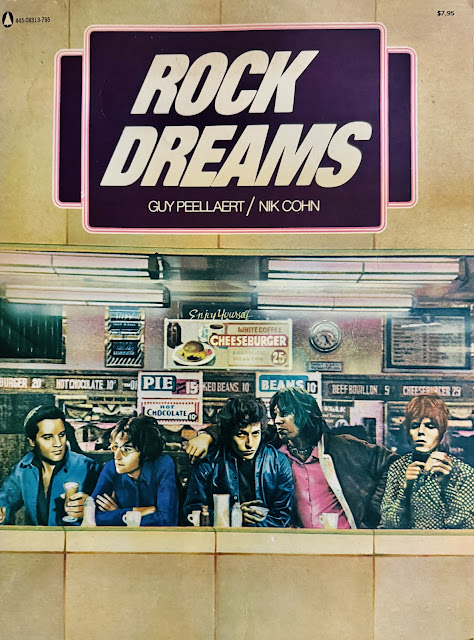You get to be a gay man of a certain age in the city that never sleeps, and sometimes you can find a personal connection to museum exhibits as I discovered at the New York Historical Society where work by Village Voice photographer Fred W. McDarrah was on display. Anyone who's ever read this blog knows that Andy Warhol and the scene at the Factory drew me here more than anything else. Here, McDarrah has photographed Cecil Beaton taking his picture with the Johnson twins. Jed (closest to Andy) was his caretaker after Valerie Solanas nearly killed him, and eventual lover. Andy looks almost pretty, as if he put make-up on for the shoot.
Of course trans people were well-represented at the Factory and in the movies Andy made with Paul Morrissey. Women In Revolt was my bewildering first exposure to the genre. It featured three trans women whose freaky personae made me deeply uneasy. McDarrah took this photo of Jackie Curtis at a party celebrating the publication of Rock Dreams by Guy Peellaert and Nik Cohn, one of my earliest pop culture purchases.
At the time, including David Bowie in the rock star pantheon gathered at this diner (where's Paul?) was a bold, unprecedented move, one of the reasons I sprung $8 from my very tight budget for the book.
Lou Reed immortalized Candy Darling in "Walk on the Wild Side" around the same time, when I was a freshman at Columbia.
I stayed in New York the summer after my sophomore year. Tom and I ventured to the 82 Club with Niko, a hip Argentinian fencing friend of his who plowed through my unread copy of Gravity's Rainbow while wearing not much more than a black thong and clogs on the South Lawn, where pro-Palestinian demonstrators camped more than half a century later. It's quite possible that this same contingent of "female impersonators" from the club, who marched in the 4th annual Gay Liberation Day parade--the forerunner of Pride--had teased us about our age and sexual orientation a few weeks earlier. We definitely were a hit.
David and I went to see Charles Ludlam and his Ridiculous Theater Company perform in The Ventriloquist's Wife. The campy humor went way over our mostly untutored heads. Less than a decade later, Ludlam, just 44, was gone. His obituary appeared on the front page of the New York Times, the first time the Old Gray Lady listed AIDS as a specific cause of death.
Arthur Bell wrote a column for the Village Voice which allowed me to follow New York's gay scene vicariously. David and I somehow got invited to a party at his Upper West Side apartment. It was as crowded as a gay bar which may explain (but does not excuse) why I steadied myself with a foot on one of his walls. Bell, an activist as well as a journalist, organized protests against the movie Cruising. I was doing exactly that when I stumbled upon the location shoot in the Ramble. McDarrah caught Bell marching with Jill Johnston, his colleague at the Voice and author of Lesbian Nation, in the 2nd annual Gay Liberation Day parade, the first one I would have been able to attend, if so inclined. It took six years for that happen, and then only as an observer.
Would you believe it took even longer for me to work up the courage to enter the Oscar Wilde Memorial Bookshop in the West Village, despite the definitive reassurances of proprietor Craig Rodwell?
Pride & Protest: Photographs by Fred W. McDarrah also includes two gay pioneers whose influence on my "lifestyle" was incalculable, in retrospect.
 |
| Marsha P. Johnson, Fourth Christopher Street Liberation Day March (1973) |
 |
| Larry Kramer (1990) |
Oddly, it was an exhibit of photographs by Arlene Gottfried that drew me to the Historical Society, my first cultural outing since returning from Florida, mostly because of this wonderful shot which appeared in a New York Times review. A curator described her work as Diane Arbus without the snark.
 |
| "Lloyd Steir and Dogs at the Big Apple Circus" (1976) |
Turns out, Gottfried, sister of comic Gilbert, was beginning her career around the time I graduated from college. Both exhibits left me a little rueful about the professional road not taken, although the New York Daily News did once publish one of my ASPCA photos of a sea turtle rescue.
 |
| "Ocean Beach Gay Couple" (1977) |
 |
| "Marsha P. Johnson and Young Boy with Roses" (1980) |
Plenty of work hanging in other galleries also reminded me how creatively my adopted home of 50 years has been depicted in art.
 |
| "Liberty and Justice for All" by Peter Max (2001) |
 |
| "927 5th Avenue" by Michiyo Fukushima (2010) |
 |
| "Municipal Building" by Ben Shahn (1930s) |
 |
| "Ernestine & Three Friends" by John Ahearn & Rigoberto Torres (1992) |
 |
| "Canal Street" by Martin Wong (1992) |
 |
| "Contact 2,021" by Courtney M. Leonard (Shinnecock) (2021) |
 |
| "Far Eastsiders, aka: Cowgirl Mama A.B & Son Wukong" by Oscar Yi Hou (2021) |
 |
| "Nurse Tracey" by Tim Okamura (2021) |
But as much as I love New York, I've really begun to wonder if it's worth the hassle, expense, noise and occasional incivility that my much easier snowbird life at the Folly throws into high relief in the days immediately following my return.
At least for an afternoon, the Historical Society seemed to be saying "Hell, yes!"










No comments:
Post a Comment